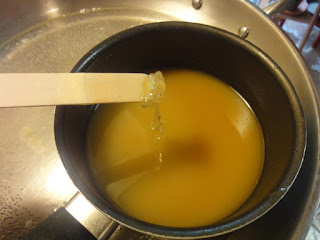A la Recherche de Cire Perdue (or, how to do the Lost Wax process)

I'm quite behind in these posts, so allow me to catch you up on our work from summer 2016 to now... In order to cast pewter, we followed the lost-wax process, using plaster molds. Lost wax is an ancient process that goes back to perhaps the 3rd millennium BCE, with the oldest known examples coming from the Cave of the Treasure hoard in southern Israel. So if you're doing this work, you're in good company. (Here's a nice paper on the history of lost wax. ) You first make a wax object, either by casting wax into a mold or sculpting something in wax directly (which would require some artistic talent, so we skipped that.) It's always a lovely sight and smell, mixing up beeswax in the kitchen. I tossed a Venus back in the pot for remelting, and she started to glow. Once you have your wax object, you have to make the plaster mold of it. Fix it well in a container, mix up your plaster, and pour. Next, you need to burn that wax figure out of the mold...

